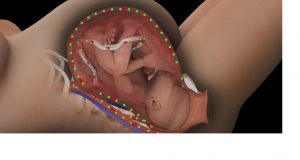A study published in the International Journal of Molecular Sciences concludes that glucocorticoids can treat hypoxic-ischemic encephalopathy (HIE) by reducing the amount of brain damage. This can prevent cerebral palsy (CP) and other brain injuries from becoming more severe.
What is hypoxic-ischemic-encephalopathy (HIE)?
 HIE is a brain injury resulting from a lack of oxygen. This can happen prior to birth, during birth, or even well into childhood.
HIE is a brain injury resulting from a lack of oxygen. This can happen prior to birth, during birth, or even well into childhood.
HIE-related injuries come in two successive stages. The first stage occurs immediately after the brain first experiences oxygen deprivation. The second stage occurs once normally oxygenated blood flows back to the brain. It is known as a reperfusion injury, and this occurs while toxins have been released from damaged cells.
Symptoms include a low or absent heart rate, irregular-sounding breathing, acidosis, seizures, low muscle tone, blue or very pale skin color, or little to no reflexes.
HIE is initially diagnosed by first using the Sarnat scale. It classifies a child’s HIE grade by determining an infant’s alertness, muscle tone, pupils, respiration, and duration. In addition, HIE can be determined by imaging such as EEG, ultrasound, and MRI.
Depending on HIE’s severity, its long-term effects can be very physically debilitating. HIE is considered a major cause of CP. It can also result in other developmental problems. They include gastrointestinal, orthopedic, sensory, cognitive pain, and limited life expectancy.
According to a March 2015 article in the Developmental Medicine & Child Neurology journal, these issues have “cost implications for the health service, social care, education provision, and the family.” They also note the likelihood of one parent not being able to work because they are the child’s primary carer. This can affect the family’s overall income.
HIE’s long-term effects can also affect a family’s quality of life by bringing potential stresses to other family members. The journal then concludes that litigation is “probably the only situation in which attempts are made to assess the prospective costs of lifetime care for the child.”
For more on HIE, this link provides in-depth information.
What are glucocorticoids?
Glucocorticoids are steroid hormones that are used for reducing inflammation and suppressing the immune system. Conditions they treat include allergies, arthritis, asthma, autoimmune disorders, cancer, and lupus. They are also naturally occurring in the body. Our adrenal glands naturally secrete glucocorticoids as a response to stress.
California study
California scientists experimented with different treatments for HIE in neonatal rats. They used two glucocorticoids, dexamethasone, and hydrocortisone. Scientists used the Rice-Vannucci rat model of HIE. The Rice-Vannucci model involves inducing HIE in rats. It means deliberately creating the conditions that allow for HIE to form.
They discovered that glucocorticoids could prevent HIE from becoming severe in rat brains. When injected directly into the brain, dexamethasone significantly helped reduce the amount of brain tissue from dying. However, it had no effects when administered nasally. Hydrocortisone injected directly into the brain helped prevent significant brain tissue from dying. It also helped protect from brain injuries when administered through the nose in male rats. In addition, they also noticed that inflammatory injury combined with hydrocortisone significantly reduced the amount of brain tissue dying out.
They concluded that glucocorticoids “have a promising therapeutic effect of neuroprotection in a rat model of neonatal HIE.” However, researchers note that future studies are needed to help study how glucocorticoids protect the neonatal brain from further damage.
Is there another method of treating HIE?
Therapeutic hypothermia is considered the only accepted treatment for HIE. It works by lowering the brain to a lower temperature, so as to prevent further damage. It works by applying a special cap that cools the newborn’s skull in a controlled temperature. Therapeutic hypothermia helps preserve central nervous system tissue. It also reduces swelling in the brain.
An Oxford University and Imperial College London study noted that there was a relationship between therapeutic hypothermia and asphyxial encephalopathy. Asphyxial encephalopathy means brain damage because of a lack of oxygen to the brain. It determined that children who underwent therapeutic hypothermia and standard care were more likely to survive than children who only received standard care.
The experiment involved randomly assigning 325 newborns to either standard care or standard care with therapeutic hypothermia. 145 children received therapeutic hypothermia besides standard care. 132 children received only standard care, which was considered. 52 percent of children in the hypothermia group survived with an IQ of 85 or more. By contrast, only 39% in the control group survived with an IQ of 85 or more.
 Lawsuit Information Center
Lawsuit Information Center

